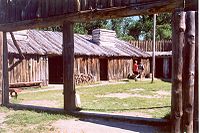
Fort Mandan
Encyclopedia

Lewis and Clark Expedition
The Lewis and Clark Expedition, or ″Corps of Discovery Expedition" was the first transcontinental expedition to the Pacific Coast by the United States. Commissioned by President Thomas Jefferson and led by two Virginia-born veterans of Indian wars in the Ohio Valley, Meriwether Lewis and William...
wintered in 1804-1805. The encampment was located on the Missouri River
Missouri River
The Missouri River flows through the central United States, and is a tributary of the Mississippi River. It is the longest river in North America and drains the third largest area, though only the thirteenth largest by discharge. The Missouri's watershed encompasses most of the American Great...
approximately twelve miles from Washburn, North Dakota
Washburn, North Dakota
Washburn is a city in McLean County, North Dakota in the United States. It is the county seat of McLean County. The population was 1,246 at the 2010 census...
, though the precise location is not known for certain and may be under the nearby river.
The fort was built of cottonwood lumber cut from the riverbanks. It was triangular in shape, with high walls on all sides and a gate facing the riverbank. The Corps of Discovery
Lewis and Clark Expedition
The Lewis and Clark Expedition, or ″Corps of Discovery Expedition" was the first transcontinental expedition to the Pacific Coast by the United States. Commissioned by President Thomas Jefferson and led by two Virginia-born veterans of Indian wars in the Ohio Valley, Meriwether Lewis and William...
started the fort on November 2, 1804, and remained in the area until April 7, 1805. They built the fort slightly down river from the nearby Mandan tribe's village. The Mandan were a tribe that Lewis was specifically told to trade with by then President Thomas Jefferson
Thomas Jefferson
Thomas Jefferson was the principal author of the United States Declaration of Independence and the Statute of Virginia for Religious Freedom , the third President of the United States and founder of the University of Virginia...
.
During the Corps' stay at the Fort, the Sioux
Sioux
The Sioux are Native American and First Nations people in North America. The term can refer to any ethnic group within the Great Sioux Nation or any of the nation's many language dialects...
threatened to attack the Mandan village along with the explorers. Although several small parties of Sioux did attack, no major conflict arose. Also, the winter was very cold with temperatures sometimes dipping to minus 45 degrees Fahrenheit and quite a few men of the expedition were frost-bitten.
When the Corps passed back through the area in August 1806 on their return journey home, the fort had burnt to the ground; the reason is unknown. Since that time, the Missouri River
Missouri River
The Missouri River flows through the central United States, and is a tributary of the Mississippi River. It is the longest river in North America and drains the third largest area, though only the thirteenth largest by discharge. The Missouri's watershed encompasses most of the American Great...
has slowly eroded its bank and has shifted to the east, covering up what remained of the charred fort.
A replica stands along the river, 2.5 miles from the intersection of ND 200A and US 83. It is located near the North Dakota Lewis and Clark Interpretive Center
North Dakota Lewis and Clark Interpretive Center
The North Dakota Lewis and Clark Interpretive Center opened in 1997 outside of Washburn, North Dakota . Overlooking the Missouri River, the center focuses on the Lewis and Clark Expedition, specifically the time they spent in the area that would eventually become the state of North Dakota...
.

